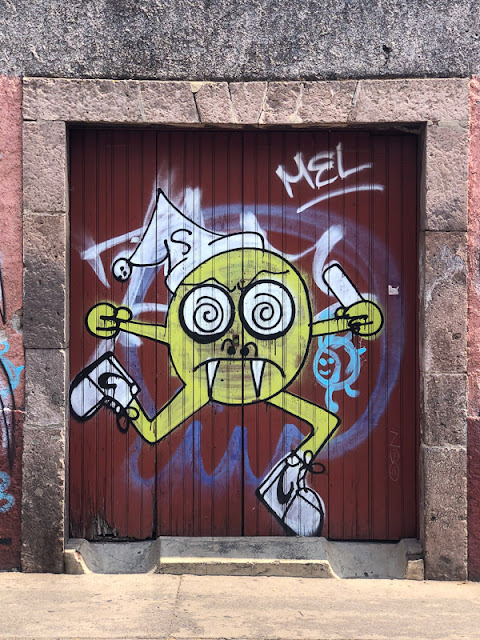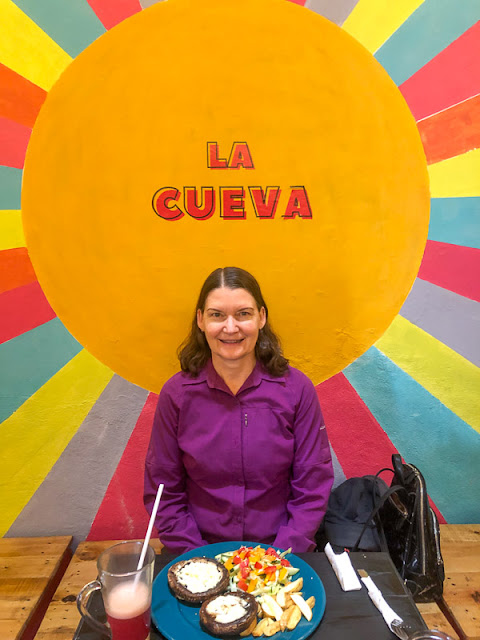We took a bus from Mexico City to Morelia. The bus seats were comfortable because they reclined and had foot rests, so we didn't mind the four hour ride.

Morelia is located in the Mexican state of Michoacán. We had time to walk around so we went to the Cathedral Plaza and saw this colorful sign for the city.

We liked this door with its metal head that seemed to be a combination of indigenous and modern elements.

The next day we wanted to explore more around the city. We walked toward the old aqueduct and found ourselves on Callejón del Romance, The Little Street of Romance. Unfortunately the fish fountain wasn't running, but it was still charming.

Further down the narrow street was another fountain, this time with water. We were struck with all the impressive stones used to construct the buildings.

Callejón de Romance is called the most beautiful street in Morelia. These days it is filled with couples' locks who are proclaiming their commitment to each other.

Nearby was Fuente de Las Tarascas, The Fountain of the Three Tarascan Princesses. They are holding a basket of regional fruits. The Tarascan people lived in this area starting in the 12th century. Behind the fountain was Acueducto, The Aqueduct, which dates back to 1549.

It had to be reconstructed using stone in the 17th century after the wooden original collapsed.

Pete captured this photo of a charming niche in the Aqueduct.

With 253 arches, the Aqueduct spans much of the historic center of Morelia.
We spotted several stickers featuring this cheerful mouse as we strolled.

We are always on the look out for street art, and we saw this piece by La Artesana de Chuspata, The Tule Artist. The fish at the bottom appears to be woven of tule. The building didn't have a ceiling and there was a warning sign that it might collapse.

We are always on the look out for street art, and we saw this piece by La Artesana de Chuspata, The Tule Artist. The fish at the bottom appears to be woven of tule. The building didn't have a ceiling and there was a warning sign that it might collapse.


Curious about the building, we stopped to check out Museo de Arte Contemporáneo de Alfredo Zalce, The Alfredo Zalce Contemporary Art Museum. It had been his home before he left it to the city.

We liked the triangular windows with views of mature trees.

This piece is La Comunidad, The Community, by Carmen Jacobo.

Wanting to see works of local artisans, we went to Instituto de Artesano Michoacano, which is located on Plaza San Francisco in the former Church of San Francisco.
Here we saw our first sculpture of the city's namesake, José María Morelos y Pavón. Morelos is a Mexican national hero and leader in the Mexican war of independence against Spain. Even though he was a priest and not a trained soldier, he successfully led many incursions against the Spanish starting in 1810.

The next day we went to Museo Casa Natal de Morelos, Morelos' Birthplace. It had a charming courtyard. We learned that 70% of the visitors here are Mexicans who want to learn about their history. Morelia didn't feel touristy, and perhaps this is because there are fewer foreign travelers here.
This painting includes Morelos in his classic red bandana and presenting his Sentimientos de la Nación, a document outlining his program for the Mexican nation, to other independence leaders.
Next we went to Museo y Archivo Histórico Casa de Morelos, Morelos' House Museum, which he had purchased in 1802. Ironically he didn't live there much because he was fighting in the war of independence. He was captured, tried for treason and executed by firing squad in 1815.

This museum had a children's learning exhibit on Morelos featuring these puppets.

This museum had a children's learning exhibit on Morelos featuring these puppets.

We always like to see kitchens in old buildings, as they remind us how hard it was to cook then so we appreciate the ease of cooking now.

It was mango season, and we also enjoyed soursop, passion fruit, guavas, avocados, limes and bananas.


They had a little market selling a variety of vegan products. Here Pete is enjoying a creamy black bean soup. Kristina ordered broccoli soup, but it was pretty boring.


We happened upon Biblioteca Pública Universitaria y Fondo Antiguo. We appreciated the green gardens around many of the historic buildings.

Several evenings we took a walk, following the path of the aqueduct.
This pedestrian only street was especially nice in the evening.

The wrought iron work around Morelia was beautiful.

The wrought iron work around Morelia was beautiful.
Pete experimented with night time shots. The trees all had terracotta lights hanging from their branches.

We found another good vegan restaurant, this one named Tierra Mona. We were able to communicate solely in Spanish everywhere we went.

We ordered the menu of the day, which started with soup, then had a main plate.

The nopales, sautéed cacti, were delicious.

This small square is called Jardín de las Rosas, Rose Garden, although we didn't see any roses there. It was less than a block from our Airbnb apartment.

The apartment had been renovated to preserve the original stone walls as possible. We especially liked the small niche on the left, and placed our travel Buddha on it.

This photo shows the living room and dining room. The kitchen was also in the same room, to the left of the dining table.

One of the most common businesses we noticed were public notaries and each one was numbered. This one was number 109! We suspect there are so many in Morelia because it is the capital of the state of Michoacán and they serve people needing to conduct official business with the government.

Pete was looking at the Morelia map and noticed a large building, so we walked over to check it out. Just inside the front door of Palacio Clavijero was a free cultural center. We love walking around historic buildings, so we checked it out.

Here's the view from the second story window overlooking the patio.

The Cultural Institute is in the former monastery of Nuestra Señora del Carmen Descalzo, which was established in 1593, and the arched ceilings on the first floor were beautiful.
... that included images of historic local figures, such as Morelos (on the right with the red bandana) and Miguel Hidalgo y Costilla, who was known as the father of the Mexican independence army. Hidalgo, a Jesuit priest, led the people to successfully take towns in the states of Guanajuato and Michoacán, even though he had no prior military training or experience.

The dome itself was painted with important symbols of resistance and culture, like corn.

The Air, Blood and Earth exhibit by Santiago Bucio featured this portrait entitled Retrato de mi padre Don Eulogio Bucio Bucio that seemed to capture his father's roots as well as depict him as a modern Mexican man.

It was alongside this piece with the original photo of his father as a boy and his father's watch. It was entitled Genealogía roto IV, Broken Ancestry IV.

There were half a dozen exhibits at the cultural center. Nancy Valdez' piece entitled Registro de objetos del Antropoceno II made a clear statement about the current Anthropocene era that is negatively impacting the environment because of our dependence on petroleum.
A bit lighter in tone was Bellver's Catrina tatuaje, Tattooed Catrina.
All the upper halls of the building were filled with posters advocating for environmental change to prevent climate catastrophe ...

We stopped for coffee one morning and read in the local paper that there would be a celebration of the 482nd anniversary of the city. Initially founded by the Spanish as Valladolid, the name was changed to Morelia in 1828, to honor the Mexican independence hero José María Morelos y Pavón.

On the morning of the celebration, streets leading to Catedral de Morelia, The Cathedral of the Divine Savior of Morelia, were closed to cars. We were happy to get some photos without cars!

Colorful decorations were hung around the center such as in this plaza.

Here's another view of The Rose Garden. In the background is Conservatorio de Las Rosas, Rose Conservatory, which was also hung with banners in the state's colors. As we strolled around Morelia we only heard Spanish, allowing us to totally immerse ourselves by speaking only Spanish.

The banners said Morelia with the city's crest and the years 2021-2023, in honor of a music festival that took place one night after the anniversary celebration.
We saw several historic buildings with the Michoacán flags on Plaza de Armas.

Morelia is the capital city of Michoacán state. For the music festival, Palacio de Gobierno del Estado de Michoacán, The Governor's Palace, was lit up too.

We walked around that evening, enjoying a variety of live music.

Next we will go to San Miguel de Allende and meet up with Cynthia for a few days.

Morelia is the capital city of Michoacán state. For the music festival, Palacio de Gobierno del Estado de Michoacán, The Governor's Palace, was lit up too.

We walked around that evening, enjoying a variety of live music.

Next we will go to San Miguel de Allende and meet up with Cynthia for a few days.































